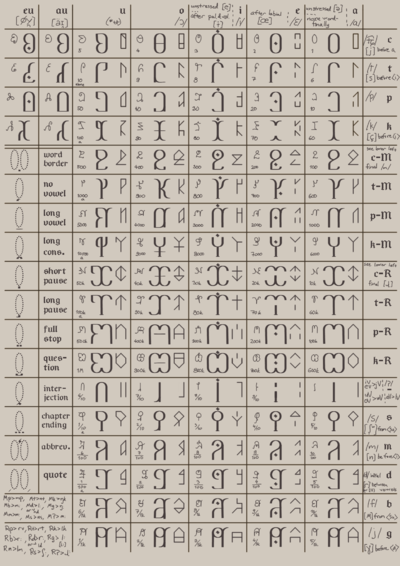User:Juhhmi/Lethusian
Classical Lethusian ('a'etuti) was spoken in the south-western Land of Rain to a varying degree from 2500 to 1500 BP. This page presents the standard used 2000 years before present and the post-classical language from which modern daughter languages mainly evolved.
Phonology
Consonants
| Bilabial | Alveolar | Palatal | Velar | |
|---|---|---|---|---|
| Nasal | m | |||
| Plosive | p b | t d | c | k g |
| Fricative | s | |||
| Trill | r |
| Bilabial | Labio-dental | Alveolar | Post-alveolar | Retroflex | Palatal | Velar | Glottal | |
|---|---|---|---|---|---|---|---|---|
| Nasal | m | n | ŋ | |||||
| Plosive | p | d̺ | t̠̻ | k | ʔ | |||
| Fricative | ʍ | f v | s | ʃ ʃ̩ʷ | ç | ɣ | ||
| Affricate | t͡ɕ | |||||||
| Approximant | w | ɻ | j | |||||
| Trill | r | |||||||
| Flap or tap | ɾ | |||||||
| Lateral approximant | l | ʟ | ||||||
| Lateral flap | (ɺ) |
- /t/ is [t̠̻], that is, laminal alveolar or postalveolar
Vowels
| Phonemic | Post-Classical Phonetic | |||||
|---|---|---|---|---|---|---|
| Front | Back | Front | Central | Back | ||
| Close | i | u | Close | i | ɨ | u̟ |
| Close-mid | e | o | ||||
| Mid | e | o | Mid | ə | ɔ̝ | |
| Open-mid | ɛ œ | |||||
| Open | a | Open | ɑ | |||
- /ɑ/ is not word-finally and is schwa [ə] when unstressed. However, preceded by a stressed, closed syllable (with coda), final /ɑ/ exists as schwa.
- /e/ is [œ] after labials. Dialectally schwa when unstressed.
- /i/ is [e] when unstressed, [ɨ] after palatal and velar consonants. Dialectally [ʏ̜] when not alveolar.
- /o/ is [ɔ̝], but appears as [o] in closed syllables.
- /u/ is [u̟]
Diphthongs
Suprasegmentals
Stress
Alternation
Assimilation of closed syllable codas
Sound changes
Orthography
Classical Lethusian was written from right to left on rows scripta continua, that is, without space between words. If necessary, the word border mark was used. The writing system was a syllabary: one grapheme corresponds to a set of sounds (onset and rime) forming a syllable. All syllables of the particular language required a consonantal onset (no word-initial vowels).
The chart on right shows old monumentals/runes (regional, 3000 BP), classical majuscules (standard, 2000 BP; not showing obsolete additions) and cursive handwriting (vernacular, 1000 BP) of Central Lethusian. Sounds correspond to the post-classical language after the Fall of Grehtkeepers after 6:138 (1410 BP). Modified versions of the script are still in use among Lethusian daughter languages and their neighbours, which will be demonstrated later.
Numbers
Number system is base desimal, but their symbols are the same as syllable graphemes (compare e.g. Classical Greek). Larger values precede (rightmost) the lesser ones i.e. symbol for (1000) comes before that of (10). Negative numbers are formed by inverting the order. If there is only one negative number symbol, "No vowel" diacritic is used to indicate its negativity.
One thing to note is that even powers of ten appear twice; the symbol #1 ending the series of same power is used a stand-alone (or final) number whereas the symbol #2 beginning a new set is used when accompanied with other numbers. Example: "I have (10#1) apples, but you have (10#2)(4) [=14] of them."
Diacritics as arithmetic symbols: - Question diacritic as "equals" sign, placed under the first symbol of the result. - Word separator between numbers to be summed or subtracted: (10)(1).(2)(10)?,(1) [11-12=-1] - Abbreviation mark between factors to be multiplied: (2)z(3)?(6) - Fractional number utilized in multiplication to get division but "no consonant mark can be used in the first grapheme of the divisor (follows dividend). - For exponentiation, the abbreviation mark is used twice: (2)zz(3)?(8) - Multiplication and expononentiation used also for numbers larger than 1M, and the compound may be placed in quotes: '(10k)zz(2)'
Fractional number symbols come last. Symbol for 'a is utilized as a decimal point if there is not a fraction small enough; larger number is borrowed from larger powers of ten respectively. Example: (4)(1/1000)z(1/10) ? (4/10)a(10000) [0.4001].
Basic Grammar
Huge number of declensional cases which convey more information than verbs which remain rather unconjugated.
Word order quite free, but verb-final sentence structure most common
Also positionals and descriptive nouns instead of adjectives. (mixing mayan and yaguan)
Language as Religion
In sacred language, every commendable leader should receive their own case symbolizing their deeds and derived from their name.
- Confirmed by a group of high religious leaders.
- Core cases (agent, object, subject, experiencers) are rarely altered, but exceptation occur:
- Aucar the Maker (/äɪ̯jɑɻ/) was exalted into agentive to memorate her great building projects which she also participated as a builder during the years of peace.
- Objective was named in the memory of little Ongeta the Innocent, who was murdered after his first month of rule by fanatics.
- Example: Kebedaur kupemta bileta sepa. [kɛfɛläɪ̯ɻ̩ kʊpɛntə filɛt sɛp] (soldier-agent.active rock-object.experiencer past-temporal.momentary throw > "The soldier threw a rock.")
- Too many cases so some fall out of use
"We speak history yet scribes pass it forward [altering it]."
Architecture: Yellow Riverside Palace
